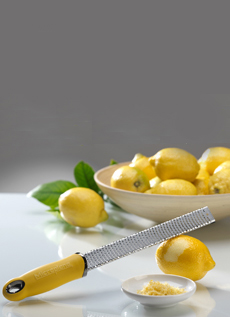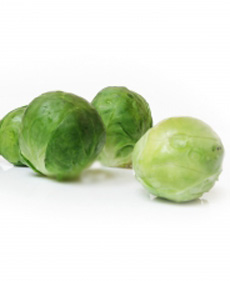TIP OF THE DAY: 10 Chef’s Tricks To Change Up Your Foods (Part 1)
 Slice, caramelize and add to salads. Photo courtesy Microplane. |
Chef Johnny Gnall shares this inspiration for cooking. He calls it “Going Against The Grain: Raw Foods You Should Try Cooking And (Typically) Cooked Foods You Should Try Raw.”
Johnny chose 10 common ingredients and switched them from their typical use to “the other side.” The first five tips are presented here; the next five tips will be published tomorrow. Have fun with it and enjoy the delicious results. 1. Apples…without the pie! The next time you crave apple pie but don’t want to deal with the fuss (or the calories and gluten) of the crust, try this recipe: Start with two apples; peel, core and thinly slice them. Over medium heat, melt a tablespoon of butter and add the apples; cook for five to ten minutes, stirring often. Halfway through the cooking process, add a tablespoon of honey, agave or sugar and a pinch of cinnamon (less is more with cinnamon). |
|
|
Once everything is soft, golden brown and luscious, you are ready to eat! Feel free to top with some vanilla ice cream (if you’re feeling indulgent) or some plain yogurt (for a healthier alternative). 2. Bananas… are ready to go bananas! If you’ve ever had Bananas Foster, you know where this is going. You can turn an ordinary banana into an indulgent dessert, even without the rum, liqueur and vanilla ice cream, by caramelizing it in a pan. You up the sweetness and give the texture a kick in the pants, all in less than five minutes. Cut a banana into four pieces: first cut in half, then cut lengthwise along each half to create four flat surfaces. Melt a tablespoon of butter in a pan and add a tablespoon of brown sugar, stirring to dissolve it into the butter. Making sure your pan is hot (a few drops of water flung onto the surface should form balls and “dance”), place the bananas into the pan, flat side down. At this point, you will probably have to play with the heat to get it just right, but you want to cook the bananas just until you get a nice, caramelized crust on the outside without charring the sugar. Let them cool a bit before eating: The sugar will be hot! |
||
|
3. Butter…goes brown! This is a simple trick that will add volumes to your cooking repertoire. The next time a recipe calls for a substantial amount of butter, think about turning it into brown butter. All you have to do is heat your butter in a pan on medium-high heat, until it—wait for it—turns brown! Be careful, as things can quickly go from brown to black if you don’t pay attention, and black butter is appropriate…to be thrown away. Ideally you should have at least a half a cup of butter so that you can clearly see when it’s ready. So if a recipe calls for less, make a big batch, use what you need, and cool the rest for later use. Brown butter is a very wintery flavor and adds earthy notes to sauces, meats, vegetables, you name it.
Brown butter pairs particularly nicely with citrus, as its earthiness is balanced by bright acidity. Or just toss some vegetables in it for a fresh take on an everyday side. |
 Brussels sprouts are delicious as crudités (raw veggies). Photo by Zsuzsanna Kilian | SXC. |
|
|
4. Brussels sprouts…are just tiny cabbages! That means that you can treat them like cabbage. Some people know Brussels sprouts as the vegetable served over-boiled into unpleasantness. Cooked lightly, they are a tasty and versatile vegetable. Try them raw: Just slice off the tough bottom (where you can see the stem) and either pull off the leaves, or shred the whole head with a knife or mandolin. You need little more than some olive oil, salt and pepper to make a super-simple and tasty salad. Pickled onions or raw red onions, thinly sliced, also work quite well. Discover the delicious raw vegetable you never knew. 5. Citrus…has a secret! Some people think of oranges as the ultimate raw food. The good ones are bursting with flavor, sweet and bright as is. Lemons and limes are as versatile as a food gets, balancing saltiness and adding a bright punch to just about anything, cooked or raw. But if you put a bit of caramelization on your citrus, you unlock a rounder, earthy flavor. You can take a bit of the tart edge off and still have that bright, lemony flavor you love. Cut the fruit into rounds about a quarter of an inch thick, brush them with oil and sear them on a grill or in a very hot sautée pan. Once you get some deep brown color on a good part of the fruit’s surface, flip it and brown the other side. On the grill this should take 30 seconds or less; a sauté pan is more variable, so just keep an eye on it. Then add the caramelized citrus to a sauce or stew for a new depth of flavor. If you slice the rounds thin enough and cook them carefully, you can even add them to salads to be eaten whole, rind and all. Or keep things simple and squeeze over a piece of fish for a bright new take on a classic garnish.
|
||


